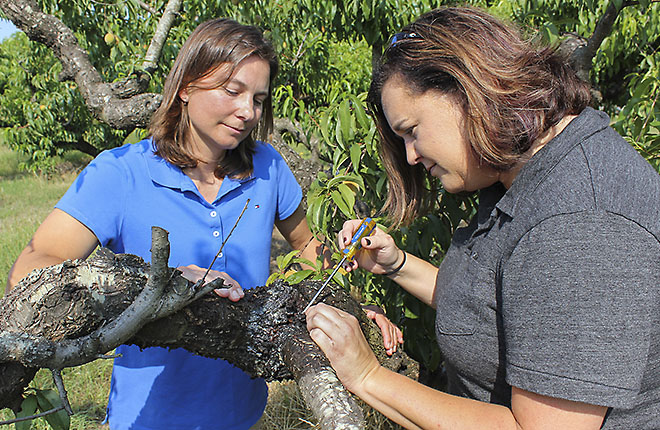Applying Beneficial Nematodes to Peach Trees
Peach growers need help with a formidable insect foe: the lesser peachtree borer, a native insect first reported in 1868 in Pennsylvania. Growers are getting this much-needed help from Agricultural Research Service (ARS) scientists in Byron, Georgia, who have developed sustainable and cost-effective ways to combat this destructive pest.
Enter the beneficial nematode Steinernema carpocapsae, a tiny roundworm that can protect peach and other stone fruit trees by attacking borer pests. They are “beneficial” in that they control insect pests in an environmentally friendly way. But the sun’s ultraviolet rays and heat can dry and kill these tiny roundworms. To survive the sun’s rays and do their job, these nematodes need protection.
There are actually two species of borers that attack peaches: lesser peachtree borers, which attack the aboveground portions of the tree, and peachtree borers (also known as “greater peachtree borers”), which attack roots. In the laboratory, S. carpocapsae nematodes proved effective in killing both borer species.
ARS entomologists Ted Cottrell and David Shapiro-Ilan, at the Southeastern Fruit and Tree Nut Research Laboratory in Byron, previously developed a way to protect the tiny worms by using the type of “fire gel” used to prevent spread of fire in residential and commercial structures. In earlier tests, they first sprayed nematodes onto tree limbs infested with lesser peachtree borers and then applied the fire gel over them.
The drawback to that earlier approach is the need for two applications (nematodes followed by fire gel). “Now the team is testing a solution of nematodes and fire gel in one spray application,” says Cottrell. “Previously, we thought of the fire gel as a moisture blanket for nematodes to protect them from drying. We found that the combined application of fire gel plus nematodes was equally effective as the previous two-step application method.”
The scientists conducted their latest study in a peach orchard in Quincy, Florida, in 2013 and 2014, applying treatments to trees infested with the lesser peachtree borer. They also compared the results of the nematode-fire gel combination with those of the chemical insecticide standard, chlorpyrifos.
“Our results indicated that the beneficial nematodes and Barricade fire gel can be applied as a single spray. In our experiments, the treatment was at least as effective as the chemical standard,” says Shapiro-Ilan. “We feel this may be a potent combination for controlling aboveground insect pests.”
This work appeared in Biological Control in December 2015.—By Sharon Durham, ARS Office of Communications.
“A Better Way To Apply Beneficial Nematodes” was published in the August 2016 issue of AgResearch Magazine.
Key Facts
- Beneficial nematodes help control peach pests.
- Fire gel protects the nematodes during and after application.
- ARS scientists improved the nematode/fire gel application method.
Full Story








